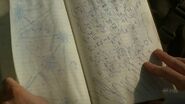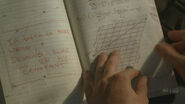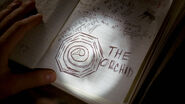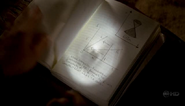Daniel's journal is a collection of notes kept by Daniel Faraday since his time as a professor of physics at Oxford University's Queen's College Physics Department. During the events of "The Constant", while trying to help Desmond, Daniel is seen frantically looking for the journal, and uses it to aid Desmond when Desmond became unstuck in time. Daniel also used the journal in "There's No Place Like Home, Part 1". The journal is also the topic of a deleted scene from the Season 4 DVD. (Season 4 Deleted Scenes transcript)
Contents

Daniel reads his journal
Within the storyline
Among other notes and experimental data, it contains the final correct settings for the consciousness time-transporter device used in the experiment with Eloise, and a note which reads, "If anything goes wrong, Desmond Hume will be my constant." ("The Constant")
On another page, a sketched version of the Orchid logo is shown, as well as some information on secondary protocol. ("The Constant")
Daniel's journal contains everything he has ever learned about the DHARMA Initiative. ("Because You Left")
Other
On one of the pages, it references "The Lorentz Invariance". Also known as "the Lorentz covariance", it is an actual property within physics. It's a key property of spacetime that follows from the special theory of relativity, where it applies globally. It was created by Nobel Prize winning Dutch physicist Hendrik Antoon Lorentz (July 18, 1853 – February 4, 1928). Hendrik Antoon Lorentz's data in various fields was later interpreted by Albert Einstein.
Another reference is made to the Kerr metric. The Kerr metric is used in general relativity to describe the geometry of spacetime around a rotating massive body, also known as a black hole. The Kerr metric is an exact solution for Albert Einstein's field equations of general relativity. These equations are highly non-linear, which makes exact solutions very difficult to find.
In "There's No Place Like Home, Part 1", Daniel flips through his journal when he hears that Keamy and his men are headed toward the Orchid. Before he lands on the right page, another page is visible. The text says:
- Using Eddington-Finkelstein
- Coordinates (V, R) removes (?) the
- Singularity at R=2m As R gets
- Smaller - Light Cones tip over.
This is all a reference to the Schwarzschild metric that was based on the Eddington-Finkelstein coordinates. The metric proves time travel in general relativity as opposed to the Minkowskian metric which is meant for 4-D real linear space. Physically, the tipping of the light cones [which are traced out by null geodesics (a coordinate invariant idea)] is an indication that timelike observers travelling across the horizon cannot escape back out beyond the horizon.
Physics forum entry on Schwarzschild metric using Eddington-Finkelstein coordinates Wikipedia entry on Eddington-Finkelstein coordinates More discussion of Faraday's Journal and the Hatch Map
| |||||||||||||||||||||||
| |||||||||||||||||||||||









